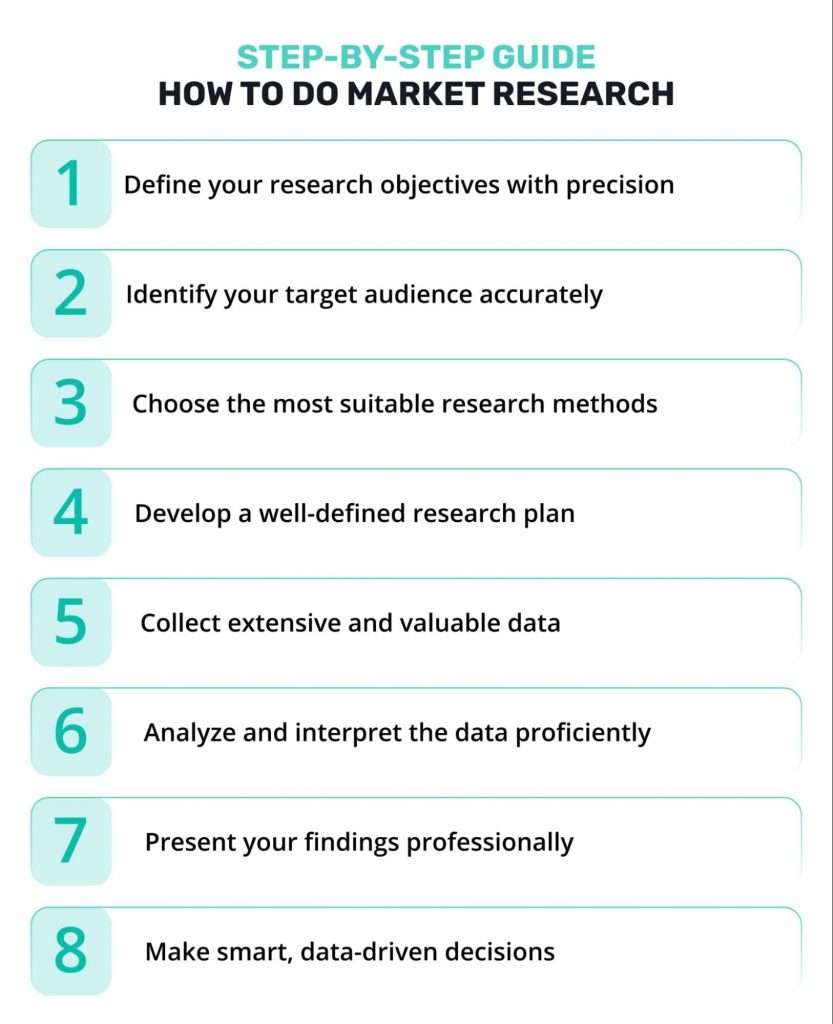Imagine launching a product that flies off the shelves or watching a marketing campaign go viral. Now, picture the opposite: a product launch met with crickets or an ad campaign that falls flat. The difference between these scenarios often boils down to one critical factor: market research. In the high-stakes business world, it’s not just a tool—it’s your secret weapon. Whether you’re a startup founder, product developer, or marketing professional, mastering market research can be your ticket to business success.
This comprehensive guide is your roadmap to conducting market research that doesn’t just inform—it transforms. We’ll dive deep into the art and science of understanding your market, from defining research objectives to analyzing data and implementing game-changing insights. By the time you finish reading, you’ll be armed with the knowledge to make decisions that aren’t just informed but inspired. Ready to turn market research into your competitive edge? Let’s dive in.
What is Market Research?
Market research is the systematic process of gathering, analyzing, and interpreting information about a target market, competitors, and the overall business environment. It’s the foundation upon which successful business strategies are built, providing crucial insights that inform decision-making across all aspects of an organization.
The importance of market research for businesses cannot be overstated. It reduces risk, identifies opportunities, and ensures that products and services align with customer needs.
Key benefits of conducting market research include:
- Identifying market opportunities and threats
- Understanding customer needs and preferences
- Evaluating competitive landscape
- Optimizing marketing strategies
- Forecasting market trends
- Improving product development
- Enhancing customer satisfaction
- Making data-driven business decisions
Types of Market Research
The main divisions of market research types are primary vs. secondary and quantitative vs. qualitative. Let’s take a look at how they differ.
Primary vs. Secondary Research
Market research can be categorized into two main types: primary and secondary research.
Primary research involves collecting original data directly from sources such as customers, competitors, or industry experts. This type of research is tailored to your specific business needs and provides up-to-date, relevant information.
Secondary research, on the other hand, involves analyzing existing data from published sources such as industry reports, government statistics, or academic studies. This type of research is often quicker and less expensive than primary research.
For example, a company launching a new fitness app might conduct primary research by surveying potential users about their exercise habits and app preferences. They might also perform secondary research by analyzing reports on the fitness app market and user demographics from industry publications.
Qualitative vs. Quantitative Research
Another important distinction in market research is between qualitative and quantitative methods.
Qualitative research focuses on gathering non-numerical data to understand motivations, opinions, and attitudes. It often involves open-ended questions and in-depth exploration of topics. Examples include:
- In-depth interviews
- Focus groups
- Observational studies
Quantitative research, in contrast, deals with numerical data and statistical analysis. It aims to quantify opinions, behaviors, or other defined variables. Examples include:
- Surveys with closed-ended questions
- Sales data analysis
- Website analytics
To illustrate the difference, consider a company researching customer satisfaction. A qualitative approach might involve conducting in-depth interviews to understand the reasons behind customer satisfaction or dissatisfaction. A quantitative approach could involve sending out a survey asking customers to rate their satisfaction on a scale of 1 to 10 and analyzing the resulting numerical data.
Step-by-Step Guide: How to Do Market Research
Market research is a crucial process that helps businesses understand their target audience, assess market conditions, and make informed decisions to drive success.

1. Define your research objectives with precision
Gain clarity on the purpose of your market research. Are you exploring customer tastes and trends, testing the appeal of a new product or service, or gauging the size and potential of your market? Your research goals should be clearly defined, as they form the foundation of your entire research project.
2. Identify your target audience accurately
Figure out who holds the keys to the information you need. Is it your existing clients, potential customers, or particular demographic segments? Correct audience identification is key to gathering reliable and relevant data.
Pro Tip: If you’re struggling to pinpoint your target audience, use Prelaunch’s Customer Clusters to quickly identify and segment your potential customers based on real data. This powerful tool helps you uncover key demographic and psychographic insights.
3. Choose the most suitable research methods
The methodology should match your objectives and chosen audience. Whether it’s primary or secondary, qualitative or quantitative, or a mixture of all, your research methods should adequately serve your research needs.
4. Develop a well-defined research plan
A comprehensive plan streamlines your research process. It includes the timeline for your research, budget allocation, individual method approaches, how you’ll obtain participants, the type of questions you’ll pose, and your data collection and analysis methods. A robust research plan ensures the effectiveness of your research.
5. Collect extensive and valuable data
Implement your research plan and gather data via surveys, interviews, focus groups, or any other methods you’ve chosen. It’s essential to collect a rich and varied data set to unearth meaningful insights.
6. Analyze and interpret the data proficiently
Leverage suitable analytical tools and techniques to dissect your data. Search for patterns, trends, and valuable insights that speak to your research objectives. This is where the true value of your research begins to emerge. It’s also where market segmentation comes into play.
7. Present your findings professionally
Transform your raw data into a comprehensive, easy-to-understand report. Use visual aids such as charts and graphs to represent your data effectively, making it easily digestible for the reader.
8. Make smart, data-driven decisions
The crux of your market research is the action you take based on your findings. Use the insights from your research to form your business strategies and decisions. Keep in mind, the true power of market research is not just in the gathering of data but in its strategic application.
Market Research Methods
Surveys and questionnaires
Surveys and questionnaires stand as versatile tools in market research. They have the potential to collect both qualitative and quantitative data from a large number of respondents, helping to grasp a broad understanding of consumer behavior and trends.
Interviews
In-depth interviews provide detailed insights into individual opinions and experiences and capture the nuances of personal perspectives. Whether structured, semi-structured, or unstructured, each approach unfolds layers of consumer thought processes, enhancing your strategic decisions.
Pro tip: Want the inside scoop on what your future customers really think? Try Prelaunch’s AI-powered in-depth interviews feature! Chat with folks who’ve already shown interest in your product, and let the AI do the heavy lifting of analyzing all that juicy feedback. You’ll get neat customer segments and spot-on suggestions to make your product even better. It’s like having a crystal ball for your launch, but way more fun (and actually useful)!
Focus groups
Focus groups involve guided discussions with small groups of participants, a unique approach that allows for the exploration of group dynamics and collective opinions. This method provides a window into communal responses to products or services and their varying influences within a shared context.
Observational research
Observational research, the subtle art of watching and recording how consumers interact with products or services in real-world settings, can reveal intricacies of consumer behavior that other methods might overlook.
Experimental research
The experimental research method, a systematic approach of manipulating variables to test cause-and-effect relationships, has a vital role in progressing aspects such as product development or pricing strategies.
Content analysis
Content analysis involves systematically analyzing communications like social media posts, customer reviews, or competitor marketing materials. This method offers a deep dive into the public perception and discourse surrounding your brand.
Social media listening
Social media listening carries an importance more than ever in this digital age. Monitoring social media platforms for mentions of your brand, competitors, or industry-related topics can help you keep your finger on the pulse of market sentiment.
Competitive analysis
Competitive analysis, a comprehensive research into your competitors’ strategies, strengths, and weaknesses, enables you to identify opportunities and threats in the market, and to build benchmarking standards for your brand.
Pro tip: Try using the Prelaunch AI Market Research tool that quickly gives you a summary of what people think of your competitors’ products based on their comment and feedback on Amazon.com. Simply find the Amazon product links, copy-paste and presto!
Tools and Resources for Market Research
This is a comprehensive listing of all the tools and resources you’ll need to conduct effective market research.
Survey Tools
- SurveyMonkey: An online survey platform that allows users to create, distribute, and analyze surveys to gather feedback and insights
- Google Forms: A free tool for creating customizable surveys and forms to collect data and responses easily.
- Typeform: A versatile survey and form-building tool designed to create engaging and interactive questionnaires.
Social Media Analytics
- Hootsuite: A social media management platform that schedules posts, monitors social media activity, and provides analytics.
- Sprout Social: A social media management and analytics tool that helps businesses manage their social media presence and engage with audiences.
- Brandwatch: A social listening and analytics tool that provides insights into brand perception and market trends through social media data.
Website Analytics
- Google Analytics: A free web analytics service that tracks and reports website traffic, user behavior, and conversion metrics.
Market Research Databases
- Statista: A statistics portal that provides access to a wide range of industry, market, and consumer data.
- IBISWorld: A market research database offering detailed industry reports and insights into market trends and forecasts.
- MarketResearch.com: A platform that provides access to a vast array of market research reports and industry insights.
Customer Relationship Management (CRM) Software
- Salesforce: A comprehensive CRM software that manages customer relationships, sales, and marketing activities.
- HubSpot: A CRM and inbound marketing platform that integrates tools for managing contacts, marketing automation, and sales.
Concept Testing Platforms
- Prelaunch: Allows you to validate product concepts quickly and efficiently, gathering valuable market feedback before full-scale launch.
Professional Market Research Services
- Nielsen: A global measurement and data analytics company providing insights into consumer behavior and media consumption.
- Ipsos: A market research firm that offers data and insights on consumer behavior, market trends, and public opinion.
- Kantar: A global data, research, and consultancy company providing insights into consumer behavior and market dynamics.
Real-World Examples of Successful Market Research
To help provide you with some context of just how integral market research is, we’ve compiled some real-world examples.
Starbucks – Building a Brand on Customer Insights
Starbucks, the global coffeehouse chain, is a prime example of a company that has leveraged market research to build a strong brand. Their success story revolves around understanding their customers deeply and tailoring their offerings accordingly.
- Understanding the Customer: Starbucks began by conducting extensive market research to identify the needs and preferences of their target audience. They discovered that customers were seeking more than just coffee; they wanted an experience.
- Creating a Unique Experience: Based on their research, Starbucks focused on creating a welcoming atmosphere, offering high-quality coffee, and providing excellent customer service. This emphasis on experience differentiation set them apart from competitors.
- Iterative Research and Development: Starbucks continuously conducts market research to refine their offerings. They gather customer feedback through surveys, social media listening, and in-store observations. This data helps them introduce new products, adjust pricing, and optimize store layouts.
- Loyalty Program and Personalization: Starbucks’ loyalty program, My Starbucks Rewards, is a testament to their commitment to customer-centricity. By collecting detailed information about customer preferences, they can offer personalized recommendations, rewards, and promotions.
Netflix – Data-Driven Content Strategy
Netflix, a global streaming service, has mastered the art of using data to inform its content strategy.
- Analyzing Viewing Habits: Netflix collects vast amounts of data on viewer behavior, including what they watch, when they watch, and how they interact with content. This data provides insights into viewer preferences and trends.
- Content Recommendation Engine: Netflix’s recommendation algorithm is powered by data analysis. By understanding individual preferences, the platform can suggest shows and movies that are likely to be enjoyed by each user.
- Original Content Development: Netflix uses data to identify potential hits for original content. By analyzing viewer data, they can identify popular genres, themes, and actors, which helps them develop shows that are more likely to be successful.
These examples demonstrate the power of market research in driving business success. By understanding customers, identifying market trends, and making data-driven decisions, companies can create products and services that resonate with their target audience, build strong brands, and achieve sustainable growth.
Common Market Research Mistakes and How to Avoid Them
When conducting market research, it’s crucial to be aware of potential pitfalls that can undermine the effectiveness of your findings. Here are some common mistakes to avoid:
Insufficient sample size is a common error that can undermine your market research efforts. Ensuring your sample size is large enough to be statistically significant and truly representative of your target population is paramount. It’s crucial to use an appropriate sample size to generate reliable findings that can guide your decision-making processes.
Leading questions in surveys is another frequent mistake. It’s vital to frame your questions neutrally to prevent biasing responses. This involves careful crafting and review of your questions to identify and eliminate potential bias. Consider having your questions reviewed by neutral parties to ensure their impartiality.
Ignoring secondary research can be damaging to your research efforts. Existing data sources can provide invaluable insights and should not be overlooked. It’s advisable to start your research process with secondary research to inform the design of your primary research. This could provide valuable context and save time and resources.
Misinterpreting data can lead to faulty conclusions and misguided strategies. It’s crucial to be cautious when interpreting your research findings. Consider all possible explanations, and don’t hesitate to seek expert help if needed. Always remember, data is only as good as the interpretations made from it.
Neglecting ongoing research is a mistake that can make your business strategy outdated. Market conditions are constantly changing, and your research should reflect this. Implementing regular research practices can help you stay updated on market trends and customer needs, keeping your business strategy relevant and effective.
The Future of Market Research
The landscape of market research is experiencing a rapid metamorphosis fostered by technological innovations and the shifting patterns of consumer behaviors. Here we delve deeper into these transformative trends:
Artificial Intelligence and Machine Learning: These technologies are revolutionizing the data analysis process. AI and Machine Learning algorithms can comb through enormous data volumes at lightning speed, unearthing intricate insights that would be arduous to glean manually, thus transforming the efficiency and depth of market research.
Comprehensive Concept Validating Software: As you can see in the Tools and Resources section above, there are several platforms available for any and all steps that go into conducting market research. One trend worth noting is that more and more, companies will seek to use tools that have an all-in-one approach so they don’t have to worry about syncing their data across multiple spaces. Trailblazing platforms like this include Prelaunch that give any creator the power to digitally test an idea before spending millions on prototyping and manufacturing.
Big Data: The escalating accessibility of vast data sets is shedding new light into consumer behavior and market trends. By analyzing this big data, researchers can gauge detailed market patterns, predict future trends, and make more informed decisions, thereby fostering a deeper understanding of the marketplace.
Mobile Research: The omnipresence of smartphones has triggered a shift towards mobile-first research methodologies. These enable researchers to connect with consumers on devices they use daily, thereby collecting real-time data and gaining more authentic and complete insights into consumer behavior.
Virtual and Augmented Reality: The advent of these cutting-edge technologies has ushered in an era of new possibilities for product testing and consumer behavior studies. VR and AR can create immersive, realistic environments where consumers can interact with products or services, offering rich, multidimensional data for market researchers.
Ethical Data Collection: Amid growing concerns around data privacy, the future of market research hinges on transparent and ethical data collection. Ensuring that data is obtained through fair practices and used responsibly is becoming paramount, as trust becomes a crucial factor in consumer relations.
Speculations indicate that the market researchers of the future will have to proficiently meld traditional research methods with emerging technologies. The emphasis will be on agility and a commitment to continued learning to keep abreast with the swiftly evolving markets.
Market Research Takeaways
Market research is a powerful tool that can drive business success by providing crucial insights into your market, customers, and competitors. By following the steps outlined in this guide and leveraging the appropriate tools and methods, you can conduct effective market research that informs your business strategies and decision-making processes.
Remember, good market research is an ongoing process. Markets are constantly evolving, and staying ahead requires continuous learning and adaptation. Whether you’re validating a new product concept, optimizing your marketing strategies, or exploring new market opportunities, make market research an integral part of your business practices.
Ready to put your market research skills into practice? Start by defining your research objectives and planning your first study. And if you’re looking to validate a new product or service concept quickly and efficiently, consider using Prelaunch.com. With its powerful concept testing capabilities, Prelaunch can help you gather valuable market feedback and set your business on the path to success.
Happy researching!




